Perlite and Rice Husk Ash Re-Use As Fine Aggregates in Lightweight Aggregate Structural Concrete—Durability Assessment
Abstract
1. Introduction
2. Materials’ Mix Design and Experimental Methods
2.1. Materials
2.2. Mix Design
2.3. Test Procedures
2.3.1. Fresh Concrete and Strength Tests
2.3.2. Open Porosity and Sorptivity Coefficient
2.3.3. Chloride Migration and Penetration Tests
2.3.4. Freeze and Thaw Test
3. Results and Discussion
3.1. Fresh Concrete Properties and Strength
3.2. Porosity and Sorptivity
3.3. Chloride Penetration and Migration Tests
3.4. Freeze and Thaw Test
3.4.1. Mass and Length Change
3.4.2. Ultrasonic Pulse Velocity
3.4.3. Water Absorption and Compressive Strength
4. Conclusions
- The workability of lightweight concrete is influenced by both the physical characteristics of the alternative aggregates used and the pre-wetting procedure. Specifically, the combination of perlite fines with coarse pumice favoured the concrete’s workability. The water trapped in the LWA pores during the pre-wetting, together with the sealing of the larger pores of the LWA by the slurry of Pe or Pu, favour and also maintain workability.
- All LWC mixtures, despite their ranking in low density classes (D1.6–1.8), developed an appropriate strength for structural use. Particularly, the incorporation of pumice and run-of-mine fine perlite yielded higher compressive strengths. Reaching a significant structural efficiency is vital, as it enhances and promotes the viability of the designed green concrete mixtures. A development of higher strength over time was also witnessed in all LWC mixtures containing Pe and Pu, relative to their content in the aggregate blend, as a result of their pozzolanic potential.
- Both sorptivity and open porosity values of the LWC mixtures increased, due to the porous nature of the used lightweight aggregates. However, the sorptivity of the mixture of perlite, coarse aggregate and pumice did not worsen significantly with respect to the REF, due to the relatively higher density of the mixture and the physical action of the fine grains of perlite. It seems that fine particles of perlite acted as filling agents and densified the microstructure and the interfacial zone of the concrete. An improvement in open porosity over time was also observed in the LWC mixtures that contained pumice, in agreement with their increase in strength.
- An excellent performance in terms of the resistance against chloride penetration was reported in all the LWC mixtures, which exhibited a further improvement with additional curing independent of the aggregate type. This fact can be accredited to the extended hydration and pozzolanic reactions, the binding capacity and the chloride pore-blocking effect. Moreover, all LWC mixtures at 90 days were classified correspondingly by both employed methods [37,39] with respect to their resistance against chloride penetration.
- In comparison to a conventional concrete mixture (REF), the LWC mixtures were susceptive to the FT cycles. The mixture of rice husk ash, perlite and pumice had the least favourable response after a few FT cycles, in relation to all the used FT indicators. The LWC mixtures with pumice also exhibited a low resistance against FT, although the combination of Pu with Pe exhibited a promising behaviour. Additional research, however, on the FT resistance of the optimized LWC mixtures is necessary.
Author Contributions
Funding
Informed Consent Statement
Data Availability Statement
Acknowledgments
Conflicts of Interest
Nomenclature
| C | Cement |
| Ca | Calcareous limestone aggregates |
| Dnssm | Chloride penetration coefficient |
| fc | Compressive strength |
| FT | Freeze-thaw |
| LWA | Lightweight aggregates |
| LWC | Lightweight concrete |
| OP | Open Porosity |
| Pe | Run-of-Mine Perlite |
| PL | Sika® Plastiment 20R |
| prW | Water pre-conditioning |
| Pu | Pumice |
| R | Rice Husk Ash |
| RCMT | Rapid Chloride Migration Test |
| RCPT | Rapid Chloride Penetration Test |
| S | Sorptivity |
| SP | Sika® Viscocrete® Ultra-420 |
| UPV | Ultrasonic pulse velocity |
References
- Official Journal of the European Union. Energy Performance of Buildings: Directive 2010/31/EU; OJEU: Aberdeen, UK, 2010. [Google Scholar]
- International Federation for Structural Concrete. Fib Model Code for Concrete Structures; FIB: Lausanne, Switzerland, 2010; pp. 1–284. [Google Scholar]
- Belussi, L.; Barozzi, B.; Bellazzi, A.; Danza, L.; Devitofrancesco, A.; Fanciulli, C.; Ghellere, M.; Guazzi, G.; Meroni, I.; Salamone, F.; et al. A review of performance of zero energy buildings and energy efficiency solutions. J. Build. Eng. 2019, 25, 100772. [Google Scholar] [CrossRef]
- Akadiri, P.O.; Chinyio, E.A.; Olomolaiye, P.O. Design of a sustainable building: A conceptual framework for implementing sustainability in the building sector. Buildings 2012, 2, 126–152. [Google Scholar] [CrossRef]
- Choi, S.W.; Oh, B.K.; Park, J.S.; Park, H.S. Sustainable design model to reduce environmental impact of building construction with composite structures. J. Clean. Prod. 2016, 137, 823–832. [Google Scholar] [CrossRef]
- Tapali, J.G.; Demis, S.; Papadakis, V.G. Sustainable concrete mix design for a target strength and service life. Comput. Concr. 2013, 12, 755–774. [Google Scholar] [CrossRef]
- European Ready Mixed Concrete Organisation. 2019. Ready-Mixed Concrete Industry Statistics. 2018. Available online: https://ermco.eu/statistics-previous-years/ (accessed on 24 December 2022).
- Tiwari, A.; Singh, S.; Nagar, R. Feasibility assessment for partial replacement of fine aggregate to attain cleaner production perspective in concrete: A review. J. Clean. Prod. 2016, 135, 490–507. [Google Scholar] [CrossRef]
- Organisation for Economic Co-operation and Development. Global Material Resources Outlook to 2060: Economic Drivers and Environmental Consequences; OECD: Paris, France, 2019. [Google Scholar] [CrossRef]
- Badogiannis, E.G.; Kotsovos, M.D. Monotonic and cyclic flexural tests on lightweight aggregate concrete beams. Earthq. Struct. 2014, 6, 317–334. [Google Scholar] [CrossRef]
- Jafari, S.; Mahini, S.S. Lightweight concrete design using gene expression programing. Constr. Build. Mater. 2017, 139, 93–100. [Google Scholar] [CrossRef]
- Bogas, J.A.; Real, S.; Ferrer, B. Biphasic carbonation behaviour of structural lightweight aggregate concrete produced with different types of binder. Cem. Concr. Compos. 2016, 71, 110–121. [Google Scholar] [CrossRef]
- Singh, B. Rice husk ash, Waste and Supplementary Cementitious Materials in Concrete: Characterisation, Properties and Applications. Wood. Publ. Ser. Civ. Struct. Eng. 2018, 417–460. [Google Scholar] [CrossRef]
- Food and Agriculture Organization of the United Nations. Rice Market Monitor; FAO: Rome, Italy, 2018. [Google Scholar]
- Knoema. Greece—Rice, Paddy Production Quantity. 2021. Available online: https://knoema.com/atlas/Greece/topics/Agriculture/Crops-Production-Quantity-tonnes/Rice-paddy-production (accessed on 24 December 2022).
- Hasnain, H.M.; Javed, U.; Ali, A.; Zafar, M.S. Eco-friendly utilization of rice husk ash and bagasse ash blend as partial sand replacement in self-compacting concrete. Constr. Build. Mater. 2021, 273, 121753. [Google Scholar] [CrossRef]
- Shameem Banu, S.; Karthikeyan, J.; Jayabalan, P. Effect of agro-waste on strength and durability properties of concrete. Constr. Build. Mater. 2020, 258, 120322. [Google Scholar] [CrossRef]
- Papadakis, V.G. Effect of supplementary cementing materials on concrete resistance against carbonation and chloride ingress. Cem. Concr. Res. 2000, 30, 291–299. [Google Scholar] [CrossRef]
- Kartini, K. Rice husk ash—Pozzolanic material for sustainability. Int. J. Appl. Sci. Technol. 2012, 47, 208–213. [Google Scholar]
- Badogiannis, E.; Stratoura, M.; Aspiotis, K.; Chatzopoulos, A. Durability of Structural Lightweight Concrete Containing Different Types of Natural or Artificial Lightweight Aggregates. Corros. Mater. Degrad. 2021, 2, 554–567. [Google Scholar] [CrossRef]
- U.S. Geological Survey. Mineral Commodity Summaries 2021; USGS: Reston, VA, USA, 2021. [Google Scholar]
- Dedeloudis, C. S&B μ-SILICA–An engineered, mineral-based SCM for durable and sustainable concrete. In Proceedings of the 2nd Global CemTrader Conference & Exhibition 2013-Cement Clinker, Supplementary Cementitious Materials (SCMs), Coal & Petcoke and Logistics for the Global Cement Cement Industry, London, UK, 23–24 May 2013. [Google Scholar]
- Kotwica, Ł.; Pichór, W.; Kapeluszna, E.; Różycka, A. Utilization of waste expanded perlite as new effective supplementary cementitious material. J. Clean. Prod. 2017, 140, 1344–1352. [Google Scholar] [CrossRef]
- Kapeluszna, E.; Kotwica, Ł.; Pichór, W.; Nocuń-Wczelik, W. Cement-based composites with waste expanded perlite—Structure, mechanical properties and durability in chloride and sulphate environments. Sustain. Mater. Technol. 2020, 24, e00160. [Google Scholar] [CrossRef]
- Bozadgiev, L. Perlite and trass-containing porcelain bodies. Interceram 1995, 44, 146–149. [Google Scholar]
- Zeyad, A.M.; Tayeh, B.A.; Yusuf, M.O. Strength and transport characteristics of volcanic pumice powder based high strength concrete. Constr. Build. Mater. 2019, 216, 314–324. [Google Scholar] [CrossRef]
- Madani, H.; Norouzifar, M.N.; Rostami, J. The synergistic effect of pumice and silica fume on the durability and mechanical characteristics of eco-friendly concrete. Constr. Build. Mater. 2018, 174, 356–368. [Google Scholar] [CrossRef]
- Stratoura, M.; Iaz, D.R.; Badogiannis, E. Chloride Penetration in Lightweight Aggregate Mortars Incorporating Supplementary Cementing Materials. Adv. Civ. Eng. 2018, 2018, 59167. [Google Scholar] [CrossRef]
- Stratoura, M.; Zavras, T.-M.; Badogiannis, E.; Sideris, K.; Papadakis, V.G. Development of durable and structural lightweight concrete. In Proceeding of the 2nd International Conference on Sustainable Materials, Systems and Structures (SMSS 2019), Rovinj, Croatia, 20–22 March 2019; Baričević, A., Jelčić Rukavina, M., Damjanović, D., Guadagnini, M., Eds.; RILEM Publications SAR: Rovinj, Croatia, 2019; pp. 413–420. [Google Scholar]
- EN 206-1:2003; Concrete—Part 1: Specification, Performance, Production, and Conformity. European Committee for Standardization: Brussels, Belgium, 2003.
- EN 12350:2019; Testing Fresh Concrete—Part 2: Slump Test. European Committee for Standardization: Brussels, Belgium, 2019.
- EN 12350:2019; Testing Fresh Concrete—Part 6: Density. European Committee for Standardization: Brussels, Belgium, 2019.
- EN 12350:2019; Testing Fresh Concrete—Part 7: Air Content. European Committee for Standardization: Brussels, Belgium, 2019.
- EN 12390:2019; Testing Hardened Concrete—Part 3: Compressive Strength of Test Specimens. European Committee for Standardization: Brussels, Belgium, 2019.
- ASTM C642-13; Standard Test Method for Density, Absorption, and Voids in Hardened Concrete. American Society for Testing and Materials: West Conchohocken, PA, USA, 2013.
- ASTM C1585-20; Standard Test Method for Measurement of Rate of Absorption of Water by Hydraulic Cement Concretes. American Society for Testing and Materials: West Conchohocken, PA, USA, 2020.
- NT Build 492-99; Concrete, Mortar and Cement-Based Repair Materials: Chloride Migration Coefficient from Non-Steady-State Migration Experiments. NORDTEST: Oslo, Finland, 1999.
- Nilsson, L.-O.; Ngo, M.H.; Gjørv, O.E. High-performance repair materials for concrete structures in the port of Gothenburg. In Proceedings of the 2nd International Conference Concrete under Severe Conditions–Environment and Loading, Tromso, Norway, 21–28 June 1998; Gjørv, O.E., Sakai, K., Banthia, N., Eds.; CONSEC: Tromso, Norway, 1998; pp. 1193–1198. [Google Scholar]
- ASTM C1202-19; Standard Test Method for Electrical Indication of Concrete’s Ability to Resist Chloride Ion Penetration. American Society for Testing and Materials: West Conchohocken, PA, USA, 2019.
- ASTM C666/C666M-15; Standard Test Method for Resistance of Concrete to Rapid Freezing and Thawing. American Society for Testing and Materials: West Conchohocken, PA, USA, 2015.
- Kim, H.K.; Jeon, J.H.; Lee, H.K. Workability, and mechanical, acoustic and thermal properties of lightweight aggregate concrete with a high volume of entrained air. Constr. Build. Mater. 2012, 29, 193–200. [Google Scholar] [CrossRef]
- Padhi, R.S.; Patra, R.K.; Mukharjee, B.B.; Dey, T. Influence of incorporation of rice husk ash and coarse recycled concrete aggregates on properties of concrete. Constr. Build. Mater. 2018, 173, 289–297. [Google Scholar] [CrossRef]
- Samimi, K.; Kamali-Bernard, S.; Akbar Maghsoudi, A.; Maghsoudi, M.; Siad, H. Influence of pumice and zeolite on compressive strength, transport properties and resistance to chloride penetration of high strength self-compacting concretes. Constr. Build. Mater. 2017, 151, 292–311. [Google Scholar] [CrossRef]
- Koushkbaghi, M.; Kazemi, M.J.; Mosavi, H.; Mohseni, E. Acid resistance and durability properties of steel fiber-reinforced concrete incorporating rice husk ash and recycled aggregate. Constr. Build. Mater. 2019, 202, 266–275. [Google Scholar] [CrossRef]
- Liu, K.; Yu, R.; Shui, Z.; Li, X.; Guo, C.; Yu, B.; Wu, S. Optimization of autogenous shrinkage and microstructure for Ultra-High-Performance Concrete (UHPC) based on appropriate application of porous pumice. Constr. Build. Mater. 2019, 214, 369–381. [Google Scholar] [CrossRef]
- Diniz, H.A.A.; dos Anjos, M.A.S.; Rocha, A.K.A.; Ferreira, R.L.S. Effects of the use of agricultural ashes, metakaolin and hydrated-lime on the behavior of self-compacting concretes. Constr. Build. Mater. 2022, 319, 126087. [Google Scholar] [CrossRef]
- Antiohos, S.K.; Papadakis, V.G.; Tsimas, S. Rice husk ash (RHA) effectiveness in cement and concrete as a function of reactive silica and fineness. Cem. Concr. Res. 2014, 61–62, 20–27. [Google Scholar] [CrossRef]
- Madani, H.; Bagheri, A.; Parhizkar, T. The pozzolanic reactivity of monodispersed nanosilica hydrosols and their influence on the hydration characteristics of Portland cement. Cem. Concr. Res. 2012, 42, 1563–1570. [Google Scholar] [CrossRef]
- Sandhu, R.K.; Siddique, R. Influence of rice husk ash (RHA) on the properties of self-compacting concrete: A review. Constr. Build. Mater. 2017, 153, 751–764. [Google Scholar] [CrossRef]
- Öz, H.Ö. Properties of pervious concretes partially incorporating acidic pumice as coarse aggregate. Constr. Build. Mater. 2018, 166, 601–609. [Google Scholar] [CrossRef]
- Rashad, A.M. A short manual on natural pumice as a lightweight aggregate. J. Build. Eng. 2019, 25, 100802. [Google Scholar] [CrossRef]
- Real, S.; Bogas, J.A.; Pontes, J. Structural lightweight aggregate concrete exposed to marine environment for 5 years. Constr. Build. Mater. 2021, 275, 122161. [Google Scholar] [CrossRef]
- Türkmen, I.; Demirboǧa, R.; Gül, R. The effects of different cement dosages, slumps and pumice aggregate ratios on the freezing and thawing of concrete. Comput. Concr. 2006, 3, 163–175. [Google Scholar] [CrossRef]
- Chen, T.T.; Wang, W.C.; Wang, H.Y. Mechanical properties and ultrasonic velocity of lightweight aggregate concrete containing mineral powder materials. Const. Build. Mater. 2020, 258, 119550. [Google Scholar] [CrossRef]
- Karakoç, M.B.; Demirboa, R.; Türkmen, I. Modeling with ANN and effect of pumice aggregate and air entrainment on the freeze-thaw durabilities of HSC. Constr. Build. Mater. 2011, 25, 4241–4249. [Google Scholar] [CrossRef]
- Lencis, U.; Udris, A.; Korjakins, A. Frost influence on the ultrasonic pulse velocity in concrete at early phases of hydration process. Case Stud. Constr. Mater. 2021, 15, e00614. [Google Scholar] [CrossRef]
- Tavasoli, S.; Nili, M.; Serpoosh, B. Effect of GGBS on the frost resistance of self-consolidating concrete. Constr. Build. Mater. 2018, 165, 717–722. [Google Scholar] [CrossRef]
- Dong, W.; Shen, X.-D.; Xue, H.-J.; He, J.; Liu, Y. Research on the freeze-thaw cyclic test and damage model of Aeolian sand lightweight aggregate concrete. Constr. Build. Mater. 2016, 123, 792–799. [Google Scholar] [CrossRef]
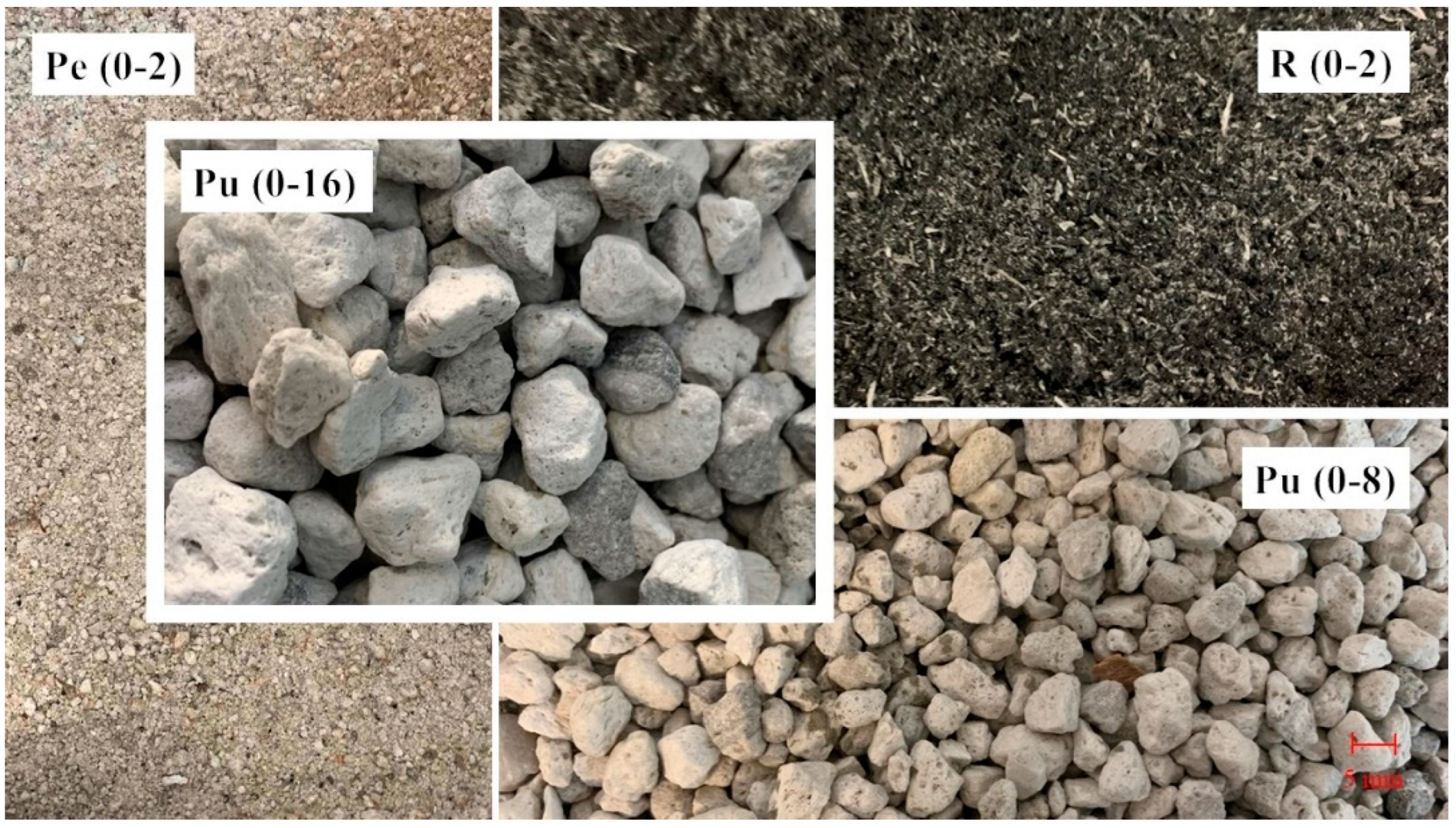
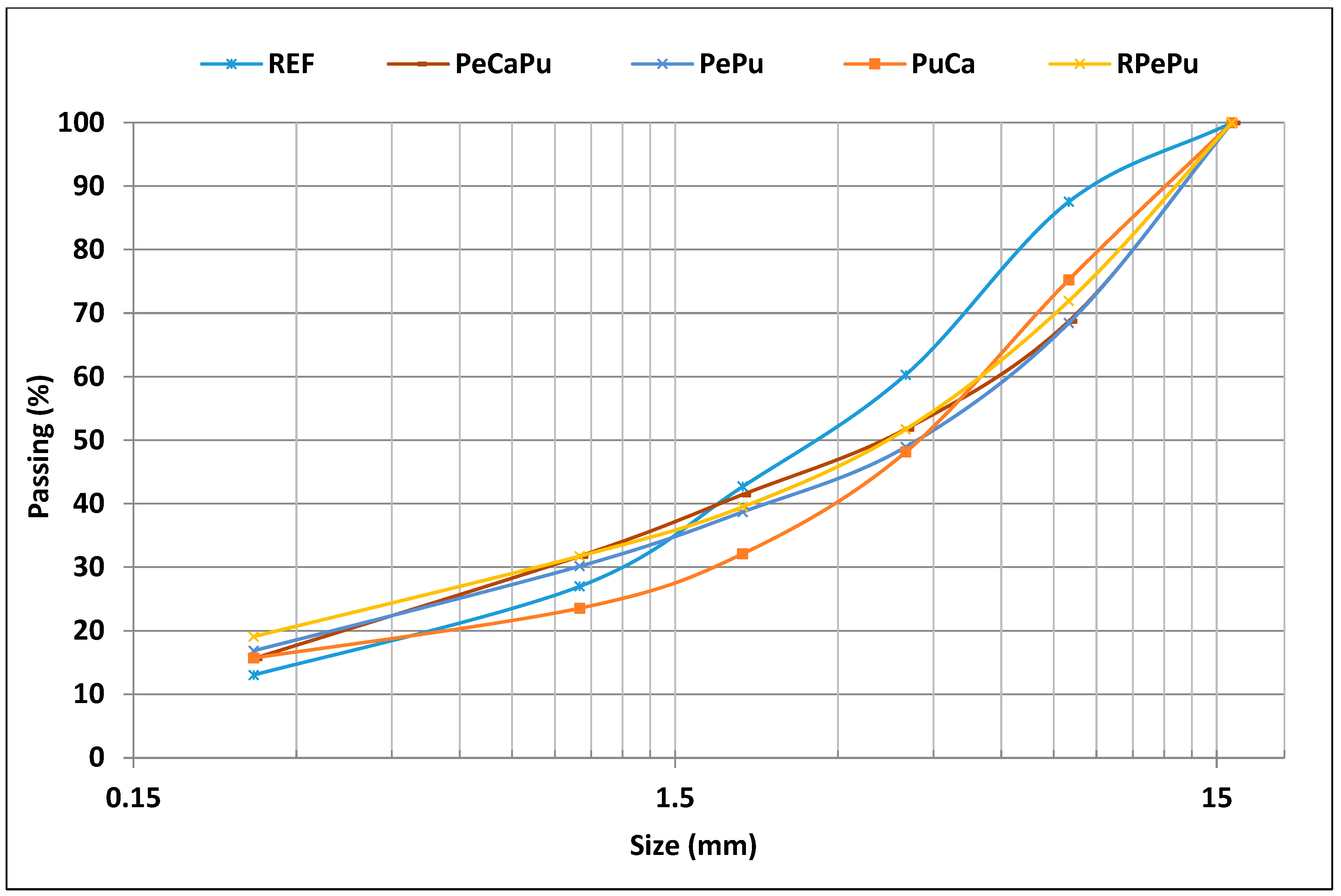
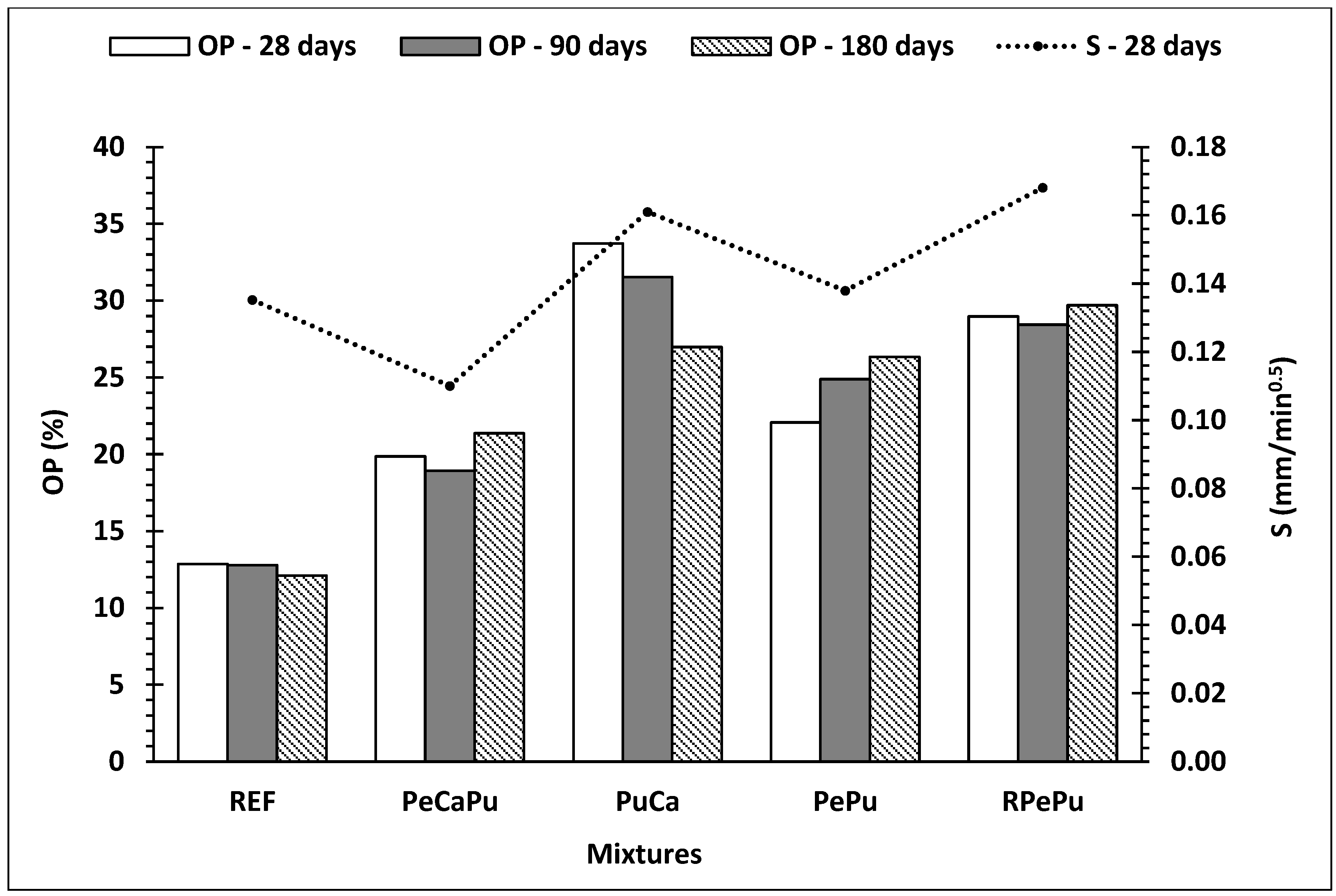
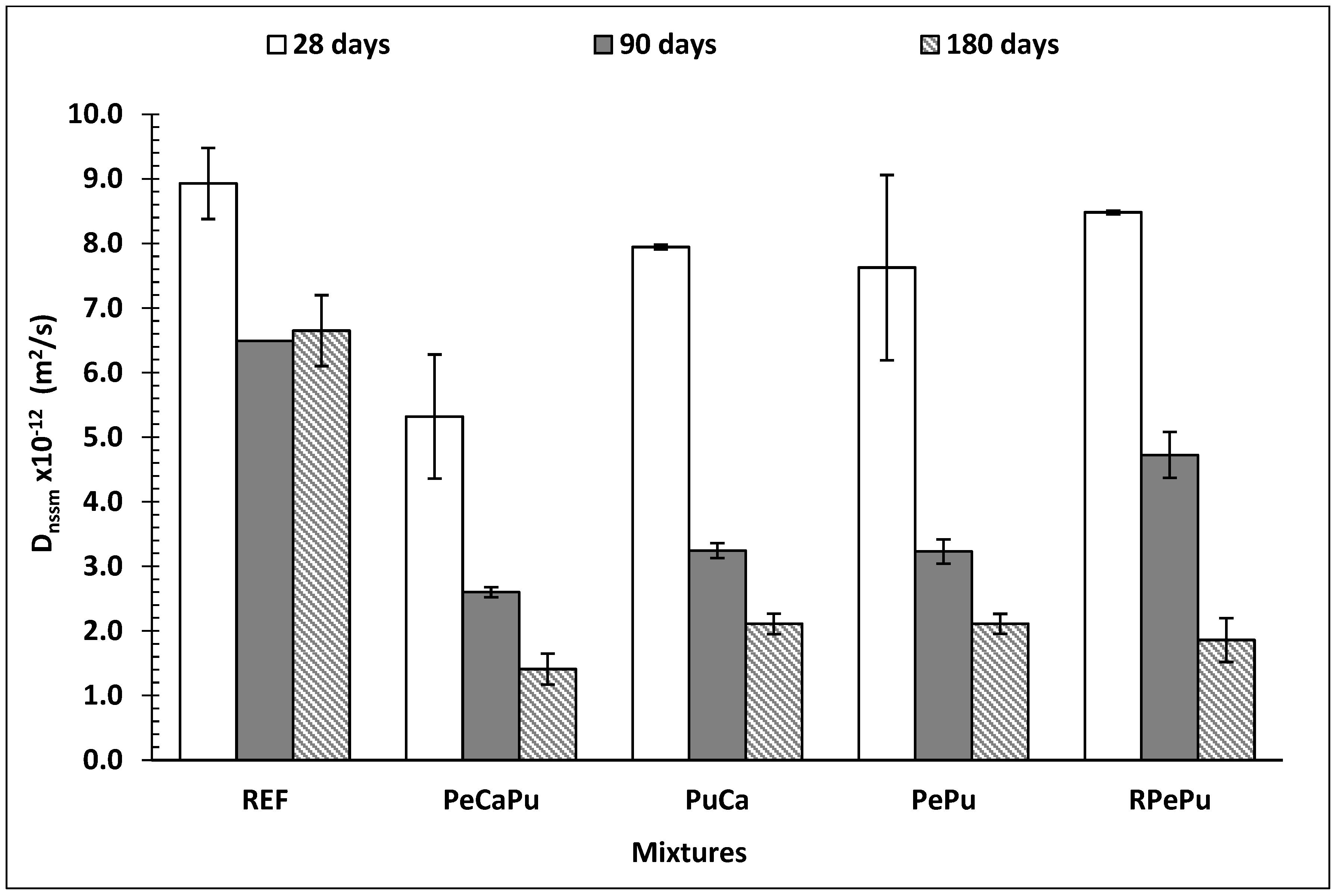
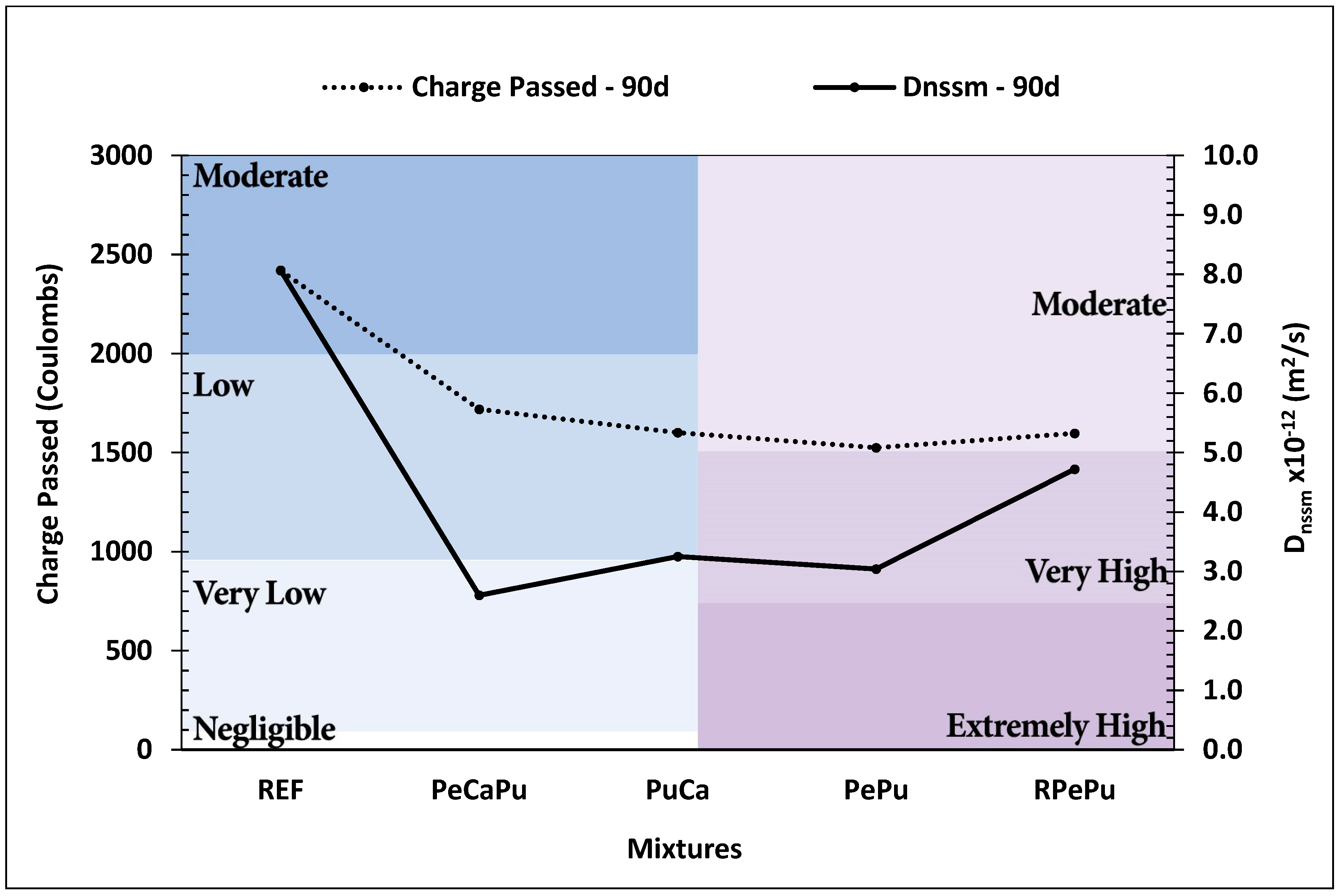
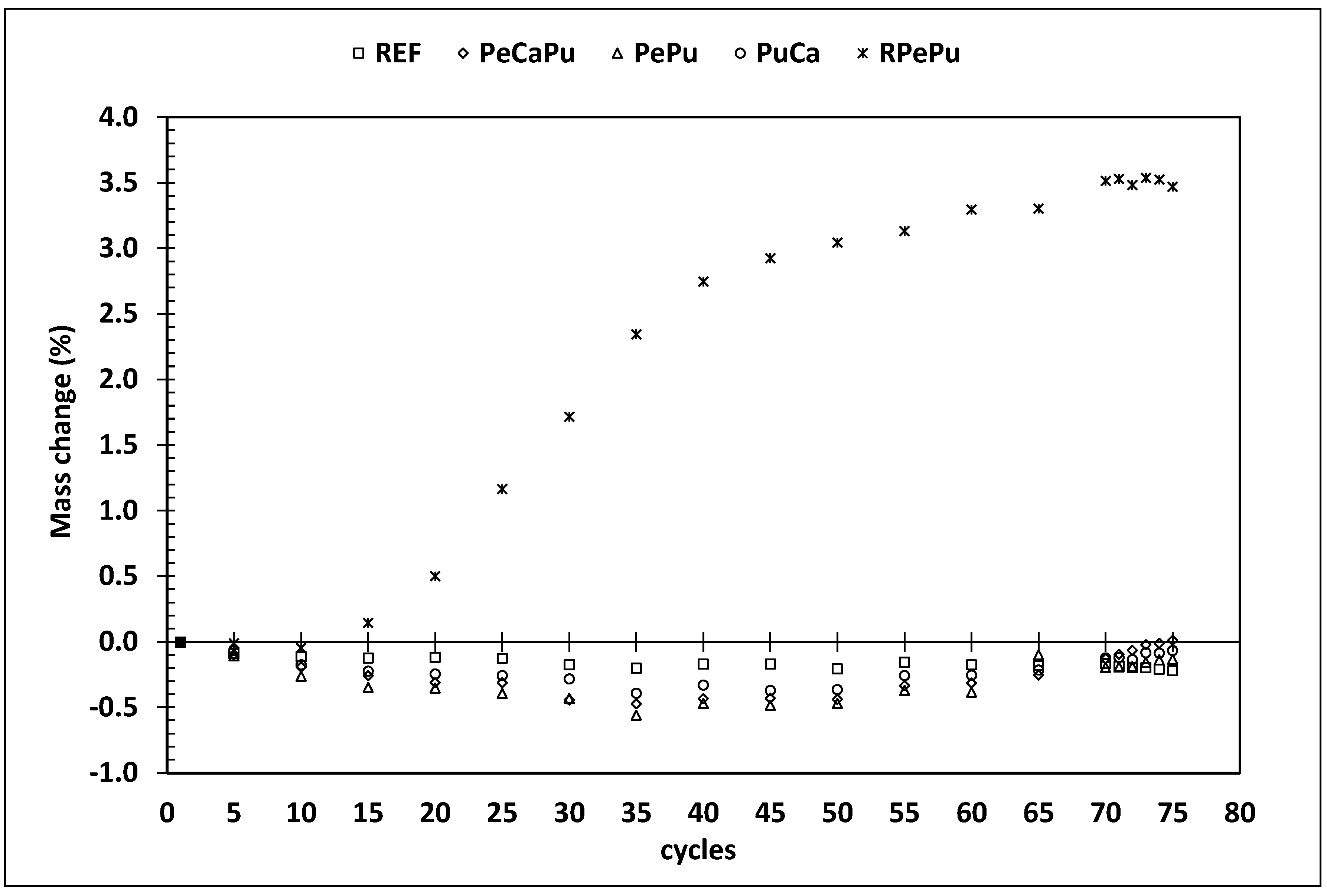
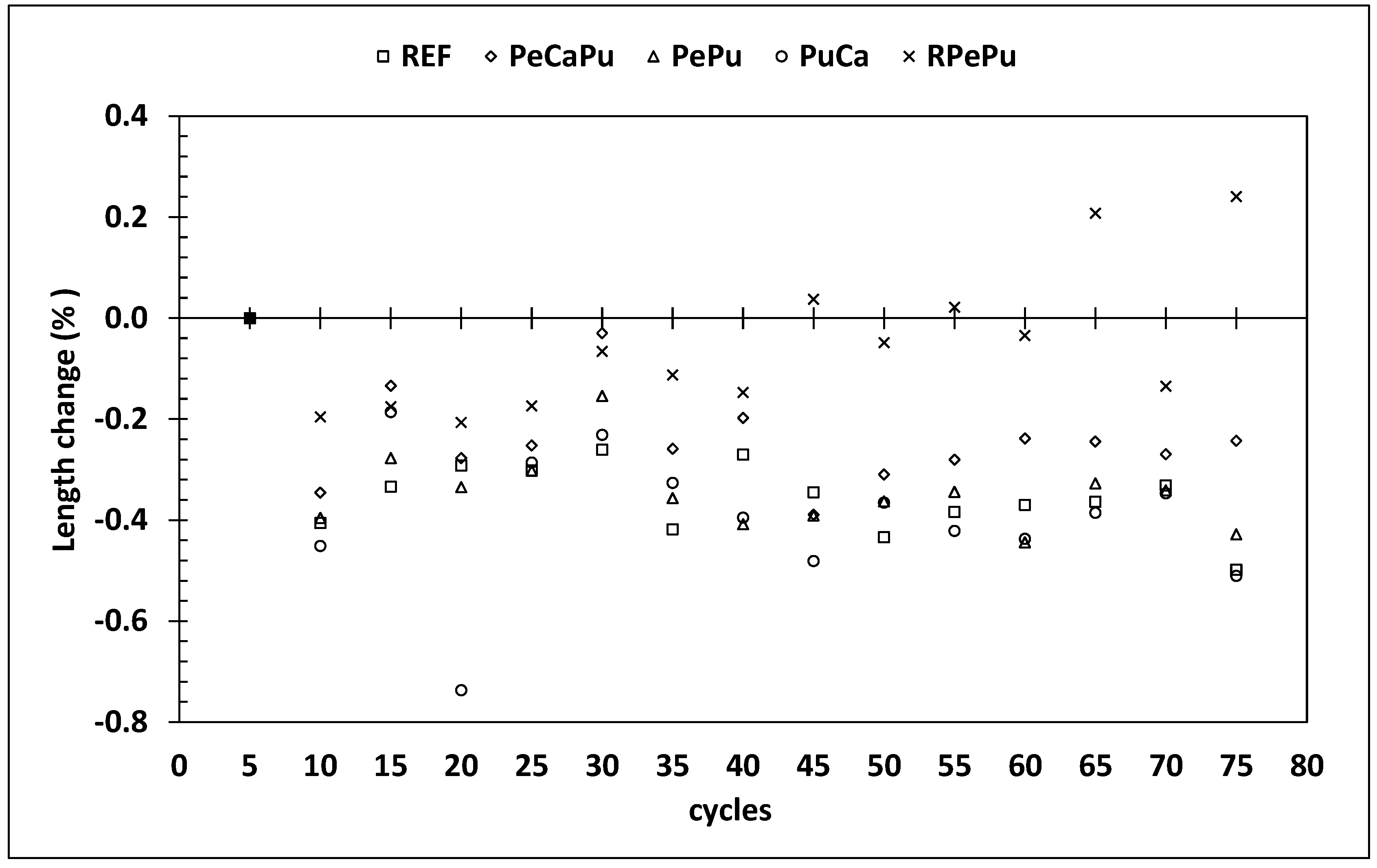
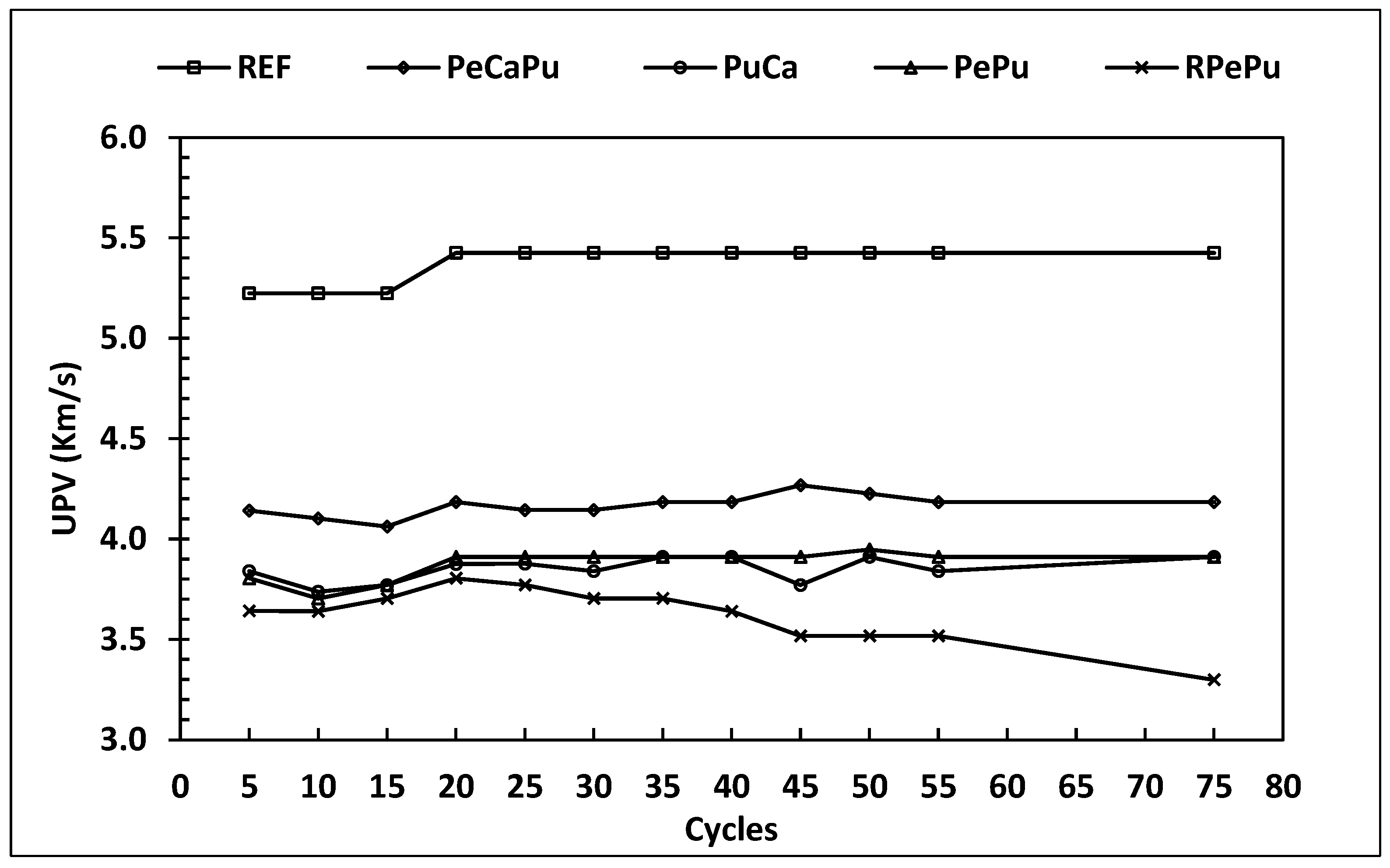
| Constituent | SiO2 | Al2O3 | Fe2O3 | CaO | MgO | SO3 | K2O | Na2O | TiO2 | P2O5 | L.O.I. |
|---|---|---|---|---|---|---|---|---|---|---|---|
| C | 18.95 | 5.22 | 3.27 | 62.51 | 2.20 | 3.63 | 0.51 | 0.38 | 0.34 | 0.09 | 2.90 |
| Pu | 68.21 | 11.83 | 1.15 | 4.09 | 0.44 | - | 4.00 | 2.76 | 0.12 | 0.03 | 7.37 |
| Pe | 73.81 | 12.97 | 1.00 | 1.40 | 0.25 | - | 3.49 | 4.49 | - | - | 2.59 |
| R | 90.61 | 0.08 | 0.45 | 1.22 | 0.48 | - | 0.84 | 0.66 | - | - | 5.66 |
| Properties | Aggregates | |||||||
|---|---|---|---|---|---|---|---|---|
| Pu (0–8) | Pu (0–16) | Pe (0–2) | Pe (0–4) | R (0–2) | Ca (0–4) | Ca (0–8) | Ca (0–16) | |
| Density, ρa (t/m3) | 1.61 | 1.13 | 2.20 | 2.15 | 1.79 | 2.67 | 2.67 | 2.61 |
| Water absorption (%) | 19.2 | 17.0 | 4.0 | 3.4 | 13.7 | 2.1 | 0.9 | 0.9 |
| Constituent (Kg/m3) | Mixtures | ||||
|---|---|---|---|---|---|
| REF | PeCaPu | PuCa | PePu | RPePu | |
| C | 400 | 400 | 400 | 400 | 400 |
| Ca (0–4) | 946 | - | - | - | - |
| Ca (0–8) | 568 | 55 | 51 | - | - |
| Ca (0–16) | 370 | - | - | - | - |
| Pu (0–8) | 607 | 397 | 402 | ||
| Pu (0–16) | - | 492 | 354 | 446 | 402 |
| Pe (0–2) | - | 109 | - | 149 | - |
| Pe (0–4) | - | 437 | - | - | 101 |
| R | - | - | - | - | 101 |
| PL | 1.2 | 1.2 | 1.2 | 1.2 | 1.2 |
| SP | 4.8 | 3.0 | 2.4 | 2.4 | 3.2 |
| prW | 29 | 98 | 177 | 158 | 162 |
| Effective water | 160 | 160 | 160 | 160 | 160 |
| Total water | 189 | 258 | 337 | 318 | 322 |
| w/c (effective) | 0.4 | 0.4 | 0.4 | 0.4 | 0.4 |
| Properties | Unit | Sample Age (Days) | No of Samples (per Age) | Size of Specimen | Standard |
|---|---|---|---|---|---|
| Slump Test | mm | - | - | - | EN 12350-2 |
| Density | - | - | - | EN 12350-6 | |
| Air Content | % | - | - | - | EN 12350-7 |
| Compressive Strength | MPa | 28 and 90 | 3 | 100 × 100 × 100 mm | EN 12390-3 |
| Open Porosity | % | 28, 90 and 180 | 2 | ∅100 × 30 mm discs 1 | ASTM C642 |
| Sorptivity Coefficient | 28 | 2 | ∅100 × 30 mm discs1 | ASTM C1585 | |
| Chloride migration test | 28, 90 and 180 | 2 | ∅100 × 50 mm discs 1 | NT Build 492 | |
| Chloride ion penetration test | Coulomb | 90 | 3 | ∅100 × 50 mm discs 1 | ASTM C1202 |
| Freeze and Thaw test | - | >90 | 3 | 70 × 70 × 70 mm | ASTM C666 |
| NT Build 492 | ASTM C1202 | ||||||
|---|---|---|---|---|---|---|---|
| Class | Description | Charge Passed (C) | Class | Description | |||
| >15 | L | : | Low | >4000 | H | : | High |
| 10–15 | M | : | Moderate | 2000–4000 | M | : | Moderate |
| 5–10 | H | : | High | 1000–2000 | L | : | Low |
| 2.5–5 | VH | : | Very High | 100–1000 | VL | : | Very Low |
| <2.5 | EH | : | Extremely High | <100 | N | : | Negligible |
| Mixture | Slump (mm) | Air Content (%) | Density (kg/m3) | Compressive Strength (MPa) | |||
|---|---|---|---|---|---|---|---|
| fc,28d | stdev | fc,90d | stdev | ||||
 |  |  |  |  | |||
| REF | 110 | 3.1 | 2378 | 79.1 | 0.8 | 79.3 | 1.9 |
| PeCaPu | 170 | 4.8 | 1682 | 35.3 | 1.6 | 39.0 | 2.3 |
| PuCa | 240 | 6.2 | 1526 | 27.6 | 1.5 | 33.2 | 1.9 |
| PePu | 200 | 5.3 | 1527 | 26.0 | 0.2 | 32.6 | 2.4 |
| RPePu | 70 | 5.6 | 1553 | 26.8 | 1.6 | 30.3 | 2.3 |
| Mixtures | fc,FT | OPFT | SFT |
|---|---|---|---|
 |  |  | |
| REF | −9 | −1 | −46 |
| PeCaPu | −25 | 24 | 5 |
| PuCa | −19 | −9 | 15 |
| PePu | 7 | −26 | −8 |
| RPePu | −26 | −8 | 212 |
Disclaimer/Publisher’s Note: The statements, opinions and data contained in all publications are solely those of the individual author(s) and contributor(s) and not of MDPI and/or the editor(s). MDPI and/or the editor(s) disclaim responsibility for any injury to people or property resulting from any ideas, methods, instructions or products referred to in the content. |
© 2023 by the authors. Licensee MDPI, Basel, Switzerland. This article is an open access article distributed under the terms and conditions of the Creative Commons Attribution (CC BY) license (https://creativecommons.org/licenses/by/4.0/).
Share and Cite
Stratoura, M.C.; Lazari, G.-E.D.; Badogiannis, E.G.; Papadakis, V.G. Perlite and Rice Husk Ash Re-Use As Fine Aggregates in Lightweight Aggregate Structural Concrete—Durability Assessment. Sustainability 2023, 15, 4217. https://doi.org/10.3390/su15054217
Stratoura MC, Lazari G-ED, Badogiannis EG, Papadakis VG. Perlite and Rice Husk Ash Re-Use As Fine Aggregates in Lightweight Aggregate Structural Concrete—Durability Assessment. Sustainability. 2023; 15(5):4217. https://doi.org/10.3390/su15054217
Chicago/Turabian StyleStratoura, Maria C., Gerasimina-Ersi D. Lazari, Efstratios G. Badogiannis, and Vagelis G. Papadakis. 2023. "Perlite and Rice Husk Ash Re-Use As Fine Aggregates in Lightweight Aggregate Structural Concrete—Durability Assessment" Sustainability 15, no. 5: 4217. https://doi.org/10.3390/su15054217
APA StyleStratoura, M. C., Lazari, G.-E. D., Badogiannis, E. G., & Papadakis, V. G. (2023). Perlite and Rice Husk Ash Re-Use As Fine Aggregates in Lightweight Aggregate Structural Concrete—Durability Assessment. Sustainability, 15(5), 4217. https://doi.org/10.3390/su15054217








